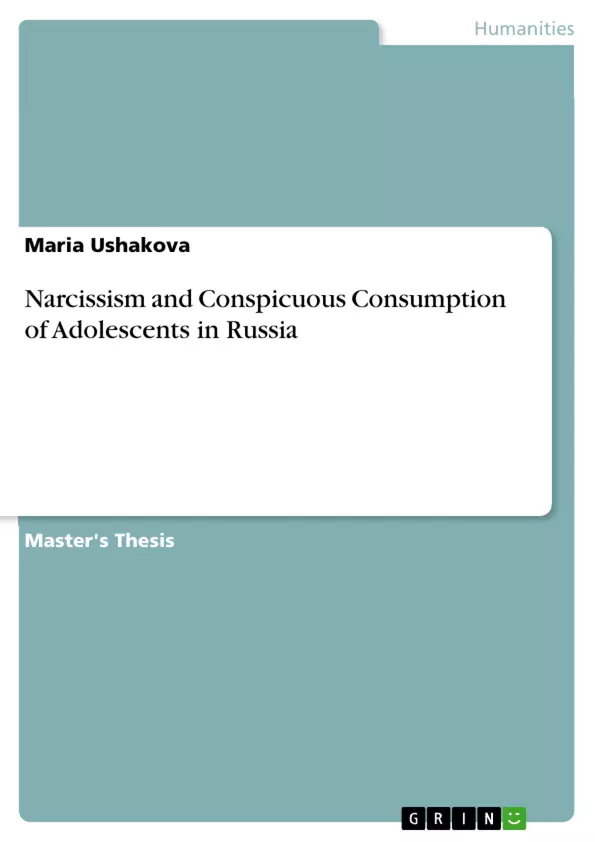The general idea of this master thesis is to investigate the phenomenon of conspicuous consumption in Russia from a totally new perspective – the perspective of a young generation of consumers with a set of motivation. Thus, the aim of this research is to examine the interdependence between narcissism and conspicuous consumption in young generation of Russian consumers.
The purchasing of goods in order to demonstrate the wealth and power for the further purpose of the status maintenance is not a new tendency for Russia nowadays. Conspicuous consumption is frequently linked with the post-communist countries, consumers of those are the worldwide famous for their love to luxury goods. Thus, historically the term refers to the upper-class people, who purchase expensive brand products in a pursuit of prestige and honor.
However, with the time and many political, economic, and social media influences, the phenomenon itself has developed. Goods-demonstrators, main players and the initial purposes have been shifted significantly. As one of the main change, the self-related motives became one of the most important group of drivers of the purchasing decision, what is especially interesting to see among the non-mature consumer segment of the country, young generation.
Being grown in modern consumer societies and spoiled by wide variety of choices, ironically young people tend to consume goods to feed their self-love. Having purchased a novelty of the season, a modern youngster hurries to make “selfie” and post it in social network to get some approvals and/or admiration, measuring in “likes”. Many scientists worldwide claim that such a habit may root in much deeper reason than just the age of technology, and even assign it to personal complexes. Deriving from the childhood, those complexes cause in the chronicle narcissism, which is dramatically increasing in people of modern society.
Inhaltsverzeichnis (Table of Contents)
- ABSTRACT
- CHAPTER 1 INTRODUCTION
- Research background
- Problem statement
- Purpose of research
- Research questions
- Structure
- CHAPTER 2 THEORETICAL FRAMEWORK
- Introduction
- Narcissism
- Individual differences
- Narcissism types
- Conspicuous consumption
- Motivation types of conspicuous consumption
- Conspicuous consumption in Russia
- Narcissism and conspicuous consumption
- Reference of both phenomenon to the young generation
- Hypotheses formulating
- CHAPTER 3 PRIMARY DATA RESEARCH METHODOLOGY
- Introduction
- Research design
- Sample decision
- Questionnaire design
- Data collection methods
- Data analyses methods
- CHAPTER 4 ANALYSIS OF RESULTS AND DISCUSSION
- Data screening and cleaning
- Descriptive statistics
- Total sample profile
- Correlation between both phenomenon
- Effect of factors on narcissism
- Effects of factors on conspicuous consumption
- Hypotheses testing
- CHAPTER 5 CONCLUSION AND IMPLICATIONS
- Summary of research findings
- Managerial Implications
- Limitations and future research
Zielsetzung und Themenschwerpunkte (Objectives and Key Themes)
This Master Thesis aims to investigate the phenomenon of conspicuous consumption in Russia, particularly focusing on the motivations of the young generation. The research examines the interdependence between narcissism and conspicuous consumption among young Russian consumers.
- Narcissism as a personality trait
- Conspicuous consumption as a behavioral pattern
- Motivational factors driving conspicuous consumption among young consumers
- The relationship between narcissism and conspicuous consumption
- The influence of demographic factors on narcissism and conspicuous consumption
Zusammenfassung der Kapitel (Chapter Summaries)
Chapter 1 introduces the research background, problem statement, purpose, research questions, and structure of the thesis. Chapter 2 explores the theoretical framework, defining narcissism and conspicuous consumption, examining their motivational types, and discussing the relationship between these two concepts. Chapter 3 delves into the research methodology, including data collection and analysis methods. Chapter 4 presents the analysis of the data, exploring correlations between narcissism and conspicuous consumption and the influence of demographic factors on both phenomena. Chapter 5 provides a conclusion of the research findings, outlining managerial implications and potential future research directions.
Schlüsselwörter (Keywords)
The key concepts explored in this thesis include narcissism, conspicuous consumption, young generation, consumer behavior, and Russia. The research focuses on the relationship between narcissism and conspicuous consumption in a young consumer segment within the Russian context.
- Quote paper
- Maria Ushakova (Author), 2017, Narcissism and Conspicuous Consumption of Adolescents in Russia, Munich, GRIN Verlag, https://www.grin.com/document/379169



